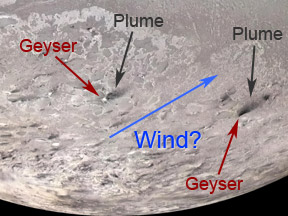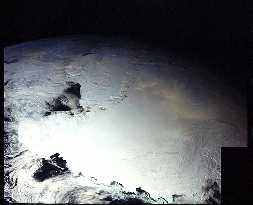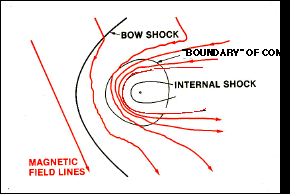This is an image of Pluto.
Click on image for full size
Image from: NASA
An Overview of Pluto's Atmosphere
It may seem hard to believe that Pluto could have an atmosphere because it is so cold at 39 AU, where Pluto resides, but it does. Because there are times when Pluto is closer to the sun than is Neptune (making it the 8th planet for roughly 20 years at a time), ices on Pluto's surface evaporate and form an atmosphere. It is continually produced and lost again as long as Pluto is inside Neptune's orbit.
The air is made mostly of nitrogen gas, just like that of the Earth and Saturn's moon Titan, with the addition of carbon monoxide (CO - what comes out of your car) and methane (CH4).
The atmosphere is also similar to that of Neptune's moon Triton.. On Triton there are seasons and motions within the atmosphere. Because Pluto has a heavier atmosphere than Triton, there may even be clouds, winds, and storms. However, seeing these clouds and winds on Pluto is difficult.
It is also possible that the presence of nearby Charon draws material escaping from Pluto's atmosphere to recondense on the surface of Charon, as suggested in this image. So this binary planet may exchange atmospheric molecules.
You might also be interested in:

Triton, by far the largest moon of Neptune, is slightly smaller than Earth's Moon. Triton has the coldest surface temperatures in our Solar System. Surprisingly, this frigid moon has an atmosphere, albeit
...more
Of all the planets and moons in the solar system, Pluto and Charon are the two which resemble each other the most closely. They are almost the same size, and they are very close together. They are so
...more
Pluto is a frigid ball of ice and rock that orbits far from the Sun on the frozen fringes of our Solar System. Considered a planet, though a rather odd one, from its discovery in 1930 until 2006, it was
...more
Pluto is so far away, and has never been explored. Questions to answer about Pluto include the following: What are the geologic features of the surface. (pictures of the surface) If there are bare spots,
...more
It may seem hard to believe that Pluto could have an atmosphere because it is so cold at 39 AU, where Pluto resides, but it does. Because there are times when Pluto is closer to the sun than is Neptune
...more
No one knows whether or not Pluto has a magnetosphere. Scientists were very surprised to find that Jupiter's icy moon Ganymede had a magnetosphere because it is hard to explain how an icy body can develop
...more
Pluto has // Call the moon count function defined in the document head print_moon_count('pluto'); known moons. Charon, the largest by far, was discovered in 1978 by the American astronomer James Christy.
...more













